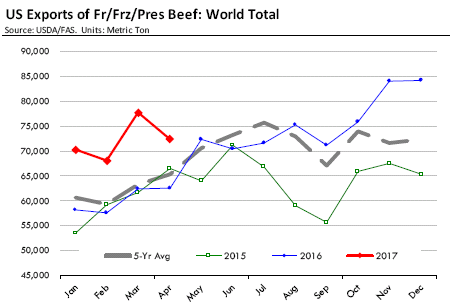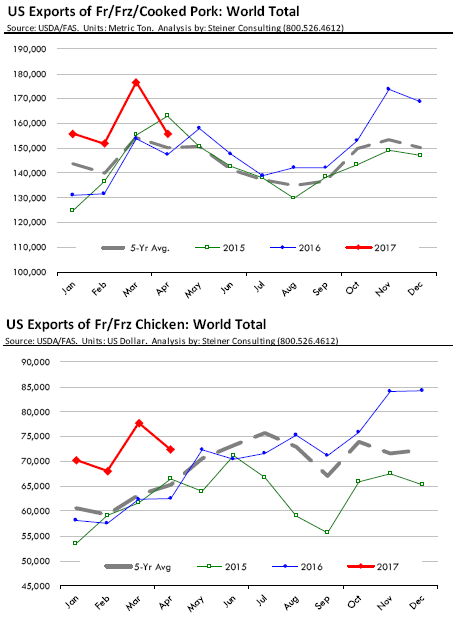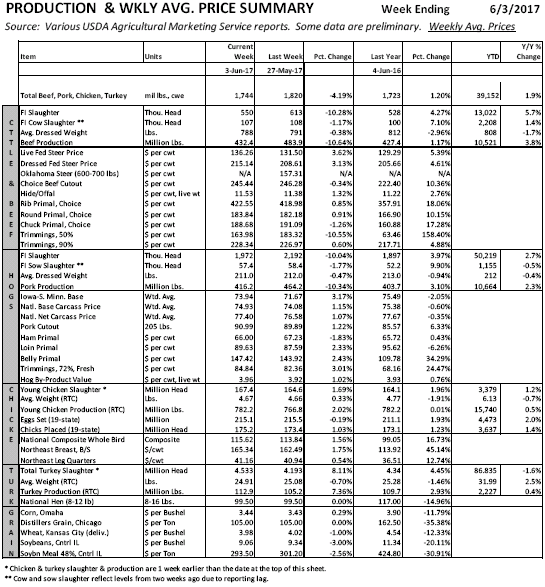



CME: Results for April Pork Export Data Better Than Expected
US - Export data for April was released on Friday and the results were even better than we expected based on the weekly reports, reports Steiner Consulting Group, DLR Division, Inc.Demand for US red meat and poultry products in global markets remains strong, helping sustain industry expansion. Below is a brief recap of the key data from the latest report and implications for May shipments.
Please keep in mind that the data is in metric ton, shipped weight basis. ERS published yesterday the conversions in carcass weight basis, which then can be used to calculate monthly domestic beef availability and per capita consumption.
Beef: Total exports of fresh/frozen and cooked beef in April were 72,354 MT, 15.7 per cent, higher than a year ago. This level of export volume far surpassed projections based on weekly shipments and helps provide some context to the very robust demand/pricing for beef in recent weeks. Japan was the top market for US beef and veal, taking 19,544 MT in April, 17 per cent more than the previous year, accounting for 27 per cent of all beef exported.
South Korea was the second largest market for US beef, taking 10,945 MT, 7 per cent more than a year ago. But the biggest contributor to the growth in US exports in April was not Japan and South Korea, it was Hong Kong. Exports to Hong Kong increased by almost 3,900 MT (+69 per cent) compared to the same period a year ago.
There has been a lot of speculation about the potential for US beef exports into China and the current trend for US exports to Hong Kong is indicative of the level of demand in this part of the world.
The meat scandal in Brazil also may have supported US beef exports as well. The challenge for expanded US access will continue to be the Chinese zero tolerance for ractopamine residues in meat.
Recently a Canadian shipment of pork feet into China was found to have ractopamine residues even as Olymel (the Canadian packer) was purchasing hogs that it thought were ractopamine free. Ractopamine and synthetic hormones will be key challenges for expanded exports to China.
Exports based on weekly shipments are projected to be up 12 per cent in May but given that April number came above estimates one could look at that growth target as conservative at this point.

Pork: April exports of fresh, frozen and cooked pork were 155,790 MT, 6 per cent higher than a year ago. Based on the weekly export data we were expecting April exports to be about flat with last year. The only market that showed a decline compared to last year was mainland China, with shipments in April at 13,494 MT down 36 per cent from last year.
Exports to most other markets registered strong increases. Exports to Mexico in April were 46,458 MT, almost 4,200 MT (+10 per cent) higher than a year ago. Mexico is now by far the top market for US pork and a stronger peso has further bolstered prospects for US shipments to that market.
Other markets, whether it is the Philippines, Colombia, or Australia, also bolstered their purchases of US pork, which is now priced quite competitively relative to pork from the European Union. The total value of fresh/frozen and cooked pork in April was $421.3 million, about $28.1 million higher than a year ago.
The value of US pork variety meats (offal) exported in April was $75.1 million, about $17 million higher than last year. The $45 million increase in pork export revenue remains a positive factor for the US pork industry, which remains on an expansionary trajectory.










